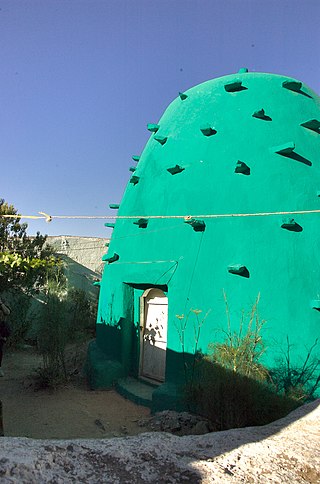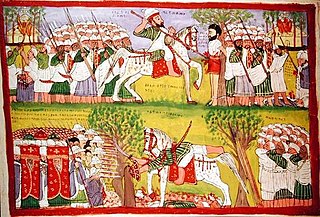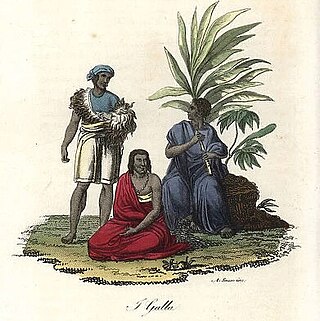
The Adal Sultanate also known as the Adal Empire, or Bar Saʿad dīn was a medieval Sunni Muslim Empire which was located in the Horn of Africa. It was founded by Sabr ad-Din III on the Harar plateau in Adal after the fall of the Sultanate of Ifat. The kingdom flourished c. 1415 to 1577. At its height, the polity under Sultan Badlay controlled the territory stretching from Cape Guardafui in Somalia to the port city of Suakin in Sudan. The Adal Empire maintained a robust commercial and political relationship with the Ottoman Empire. Sultanate of Adal was alternatively known as the federation of Zeila.

Ahmad ibn Ibrahim al-Ghazi was the Imam of the Adal Sultanate from 1527 to 1543. Commonly named Ahmed Gragn in Amharic and Gurey in Somali, both meaning the left-handed, he led the invasion and conquest of Abyssinia from the Sultanate of Adal during the Ethiopian-Adal War. He is often referred to as the "King of Zeila" in medieval texts.

Galawdewos, also known as Mar Gelawdewos, was Emperor of Ethiopia from 3 September 1540 until his death in 1559, and a member of the Solomonic dynasty. His throne name was Atsnaph Sagad I. A male line descendant of medieval Amhara kings, he was a younger son of Dawit II and Seble Wongel.

The Sultanate of Ifat, known as Wafāt or Awfāt in Arabic texts, or the Kingdom of Zeila was a medieval Sunni Muslim state in the eastern regions of the Horn of Africa between the late 13th century and early 15th century. It was formed in present-day Ethiopia around eastern Shewa in Ifat. Led by the Walashma dynasty, the polity stretched from Zequalla to the port city of Zeila. The kingdom ruled over parts of what are now Ethiopia, Djibouti and Somaliland.
Hadiya also known as Adea or Hadia was a medieval Muslim state in the southern part of its realm located south of Shewa and west of Sharkha. The Hadiya Muslim state mainly composed of Cushitic Hadiyya proper, Halaba, Kebena people as well as Semitic Sil'te and other tongues related to Harari language. Hadiya was historically a vassal state of the Adal federation and then became an autonomous province of Abyssinia in the fourteenth century while still remaining a member of the Zeila union. In the 1600s Hadiya regained its independence and was led by a Garad. By 1850, Hadiya is placed north-west of lakes Zway and Langano but still between these areas.
Hadiya, also spelled as Hadiyya, is an ethnic group native to Ethiopia in Southern Nations, Nationalities and Peoples' Region who speak the Hadiyyisa language. According to a popular etymology, the name 'Hadiyya," sometimes written in the versions Hadya, Hadea, Hadija, Hadiyo, Hadiyeh, Adea, Adia, means "gift of god" A historical definition of the Hadiya people based on the old Hadiyya Sultanate included a number of Ethiopian ethnic groups currently known by other names. Currently, this historic entity is subdivided into a number of ethnonyms, partly with different languages and cultural affiliations. In his book "A History of the Hadiyya in Southern Ethiopia," Ulrich Braukämper reported that Leemo, Weexo-giira, Sooro, Shaashoogo, Baadawwaachcho, and Libido (Maraqo) Hadiyya, Endegang subgroups remain a language entity and preserved identity of oneness, the Hadiyya proper. The term Hadiya specifically designates the Qabeena people. Other ethnic groups such as Siltʼe, Wulbareg, Azarnat, Barbare, Wuriro, Wolane and Gadabano profess that they're the seven Hadiya clans. Ancient Hadiyans are distinguished by their Muslim heritage however these populations have decreased in the following centuries. Clans of Hadiya origin in Oromia, Sidama, Wolayta, Gurage, Tigray, and Afar were completely absorbed by these nations. They were initially all inhabitants of a single political entity, a sultanate, which in the four centuries following its break-up in the mid-16th century fragmented into separate ethnic groups.

Nur al-Din or Nur ibn Mujahidibn ‘Ali ibn ‘Abdullah al Dhuhi Suha was a Emir of Harar who ruled over the Adal Sultanate. He was known for marrying his uncle's widow, Bati del Wambara, and he also succeeded Imam Ahmad as leader of the Muslim forces fighting Christian Ethiopia. He is often known as the "King of Adel" in medieval texts.

The Ethiopian–Adal War or Abyssinian–Adal War, also known in Arabic as the "Futuḥ al-Ḥabash", was a military conflict between the Christian Ethiopian Empire and the Muslim Adal Sultanate from 1529 to 1543. The Christian Ethiopian troops consisted of the Amhara, Tigrayans, Tigrinya and Agaw people, and at the closing of the war, supported by a few hundred Portuguese musketmen. Whereas Adal forces were mainly composed of Harla, Somali, Afar, as well as Arab and Turkish gunmen. Both sides at times would see the Maya mercenaries join their ranks.

Slavery in Ethiopia existed for centuries, going as far back as 1495 BC and ending in 1942. There are also sources indicating the export of slaves from the Aksumite Empire. The practice formed an integral part of Ethiopian society. Slaves were traditionally drawn from the Nilotic groups inhabiting Ethiopia's southern hinterland and Oromos. War captives were another source of slaves, though the perception, treatment and duties of these prisoners was markedly different. Although religious law banned Christian slave masters from taking part in the slave trade, many Muslim Ethiopian slave traders took part in the Arab slave trade. Slaves usually served as concubines, bodyguards, servants and treasurers.

The Oromo expansions, also known as the Oromo migrations or the Oromo invasions, were a series of expansions in the 16th and 17th centuries by the Oromo. Prior to their great expansion in the 16th century, the Oromo inhabited only the area of what is now modern-day southern Ethiopia and northern Kenya. Over the centuries due to many factors, mostly the wars between Adal Sultanate and Ethiopia would further encourage the numerous Oromo tribes to expand towards central and eastern modern Ethiopia.
The Jaarso, Giarso or Jaarsoo is a northern Somali clan, a sub-division of the Dir clan family. They largely live in Ethiopia, in the Oromo Region and the Somali Region, especially around the ancient cities of Chinaksen, Harar and between the city and Jigjiga.
Dawaro or Doaro was a Muslim principality which laid alongside the Ifat Sultanate. The state was originally independent until becoming a vassal and later a province due its subjugation by Emperor Amda Seyon I in the early 14th century. The region was situated east of Hadiya and north of Bali which covered much of Ethiopia's Arsi Province.The capital of Dawaro was called Sabboch
Bati del Wambara fl. 1531, was the Harari wife of the 16th-century general, Ahmad ibn Ibrahim, and then his successor, Nur ibn Mujahid. She was extremely influential in shaping both her husbands' military policies in their campaigns against the Ethiopian Empire.

Fatagar was a historical province that separated Muslim and Christian dominions in the medieval Horn of Africa. In the eleventh century it was part of the Muslim states, then was invaded by the Christian kingdom led by Emperor Amda Seyon I, after which it would serve as central district in, and home of multiple rulers of, the Ethiopian Empire in the 15th century.
The Battle of Hazalo was fought between the forces of Adal Sultanate led by Nur ibn Mujahid, and Oromo of Gada Michelle in 1559. Nur and his troops were returning from a victory at the Battle of Fatagar against the Ethiopian Imperial army, when they were ambushed sustaining heavy casualties. Adal's elite soldiers the Malassay were killed in large number effectively ending the Harari states regional superiority.

Hubat, also known as Hobat, or Kubat was a historical Muslim state located in present-day eastern Ethiopia. Historically part of the Adal region alongside Gidaya and Hargaya states on the Harar plateau. Hubat is today within a district known as Adare Qadima which includes Garamuelta and its surroundings in Oromia region. The area is 30 km north west of Harar city at Hubeta, according to historian George Huntingford. Trimingham locates it as the region between Harar and Jaldessa. Archaeologist Timothy Insoll considers Harla town to be Hubat the capital of the now defunct Harla Kingdom.

Early history of Harar city is generally obscure, as many documents and records differ the exact date of the origin of the city. Most historical records state that Harar's history date back to 16th century, beginning with Adal Sultanate moving its capital from Dakkar to Harar during the reign of Sultan Abu Bakr ibn Muhammad. Other rudimentary oral tradition produced in 19th and 20th century stated that Harar history dated by in the 10th century or Abadir Umar ar-Rida founded the first Harar kingdom after migrating from Arabian Peninsula to spread Islam in 12th and 13th century.
Adal, known as Awdal or Aw Abdal was a historical Muslim region in the Horn of Africa. Located east of Ifat and the Awash river as far as the coast, and including Harar as well as Zeila. The Zeila state often denoted Adal and other Muslim dominions in medieval texts.
The Battle of Webi River was fought in 1576 between the forces of Adal led by Muhammad ibn Nasir, and the Abyssinian army, under Sarsa Dengel. The outcome of this last war proved to be the end of the political importance of Harar, as the invading Muslim force was liquidated. This major defeat ended the Sultanate of Adal's status as a major military power and permanently ceased its aggression towards Ethiopia.
Abbas ibn Abun ibn Ibrahim also known as Wazir Abbas was an Adalite General who became Grand Vizier of the Adal Sultanate in 1535. The nephew of Ahmed Gurey, he led the Adalite conquest of Medri Bahri and was briefly the Bahr Negash. He was also the father of the Sultan Talha ibn Abbas.











